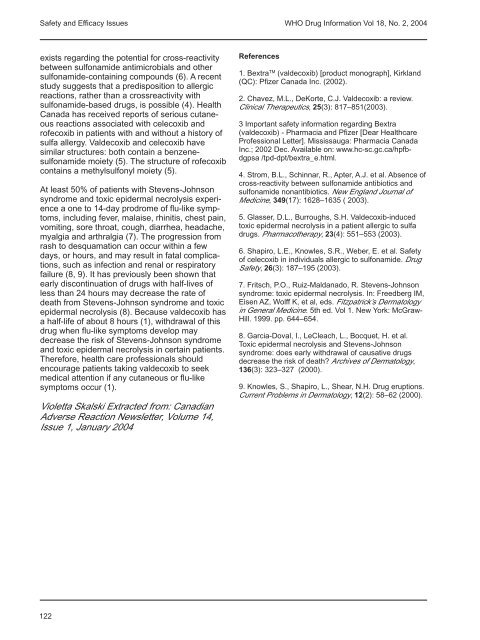WHO Drug Information Vol. 18, No. 2, 2004 - World Health ...
WHO Drug Information Vol. 18, No. 2, 2004 - World Health ...
WHO Drug Information Vol. 18, No. 2, 2004 - World Health ...
Create successful ePaper yourself
Turn your PDF publications into a flip-book with our unique Google optimized e-Paper software.
Safety and Efficacy Issues<br />
exists regarding the potential for cross-reactivity<br />
between sulfonamide antimicrobials and other<br />
sulfonamide-containing compounds (6). A recent<br />
study suggests that a predisposition to allergic<br />
reactions, rather than a crossreactivity with<br />
sulfonamide-based drugs, is possible (4). <strong>Health</strong><br />
Canada has received reports of serious cutaneous<br />
reactions associated with celecoxib and<br />
rofecoxib in patients with and without a history of<br />
sulfa allergy. Valdecoxib and celecoxib have<br />
similar structures: both contain a benzenesulfonamide<br />
moiety (5). The structure of rofecoxib<br />
contains a methylsulfonyl moiety (5).<br />
At least 50% of patients with Stevens-Johnson<br />
syndrome and toxic epidermal necrolysis experience<br />
a one to 14-day prodrome of flu-like symptoms,<br />
including fever, malaise, rhinitis, chest pain,<br />
vomiting, sore throat, cough, diarrhea, headache,<br />
myalgia and arthralgia (7). The progression from<br />
rash to desquamation can occur within a few<br />
days, or hours, and may result in fatal complications,<br />
such as infection and renal or respiratory<br />
failure (8, 9). It has previously been shown that<br />
early discontinuation of drugs with half-lives of<br />
less than 24 hours may decrease the rate of<br />
death from Stevens-Johnson syndrome and toxic<br />
epidermal necrolysis (8). Because valdecoxib has<br />
a half-life of about 8 hours (1), withdrawal of this<br />
drug when flu-like symptoms develop may<br />
decrease the risk of Stevens-Johnson syndrome<br />
and toxic epidermal necrolysis in certain patients.<br />
Therefore, health care professionals should<br />
encourage patients taking valdecoxib to seek<br />
medical attention if any cutaneous or flu-like<br />
symptoms occur (1).<br />
Violetta Skalski Extracted from: Canadian<br />
Adverse Reaction Newsletter, <strong>Vol</strong>ume 14,<br />
Issue 1, January <strong>2004</strong><br />
122<br />
References<br />
<strong>WHO</strong> <strong>Drug</strong> <strong>Information</strong> <strong>Vol</strong> <strong>18</strong>, <strong>No</strong>. 2, <strong>2004</strong><br />
1. Bextra TM (valdecoxib) [product monograph], Kirkland<br />
(QC): Pfizer Canada Inc. (2002).<br />
2. Chavez, M.L., DeKorte, C.J. Valdecoxib: a review.<br />
Clinical Therapeutics, 25(3): 817–851(2003).<br />
3 Important safety information regarding Bextra<br />
(valdecoxib) - Pharmacia and Pfizer [Dear <strong>Health</strong>care<br />
Professional Letter]. Mississauga: Pharmacia Canada<br />
Inc.; 2002 Dec. Available on: www.hc-sc.gc.ca/hpfbdgpsa<br />
/tpd-dpt/bextra_e.html.<br />
4. Strom, B.L., Schinnar, R., Apter, A.J. et al. Absence of<br />
cross-reactivity between sulfonamide antibiotics and<br />
sulfonamide nonantibiotics. New England Journal of<br />
Medicine, 349(17): 1628–1635 ( 2003).<br />
5. Glasser, D.L., Burroughs, S.H. Valdecoxib-induced<br />
toxic epidermal necrolysis in a patient allergic to sulfa<br />
drugs. Pharmacotherapy, 23(4): 551–553 (2003).<br />
6. Shapiro, L.E., Knowles, S.R., Weber, E. et al. Safety<br />
of celecoxib in individuals allergic to sulfonamide. <strong>Drug</strong><br />
Safety, 26(3): <strong>18</strong>7–195 (2003).<br />
7. Fritsch, P.O., Ruiz-Maldanado, R. Stevens-Johnson<br />
syndrome: toxic epidermal necrolysis. In: Freedberg IM,<br />
Eisen AZ, Wolff K, et al, eds. Fitzpatrick’s Dermatology<br />
in General Medicine. 5th ed. <strong>Vol</strong> 1. New York: McGraw-<br />
Hill. 1999. pp. 644–654.<br />
8. Garcia-Doval, I., LeCleach, L., Bocquet, H. et al.<br />
Toxic epidermal necrolysis and Stevens-Johnson<br />
syndrome: does early withdrawal of causative drugs<br />
decrease the risk of death? Archives of Dermatology,<br />
136(3): 323–327 (2000).<br />
9. Knowles, S., Shapiro, L., Shear, N.H. <strong>Drug</strong> eruptions.<br />
Current Problems in Dermatology, 12(2): 58–62 (2000).

















